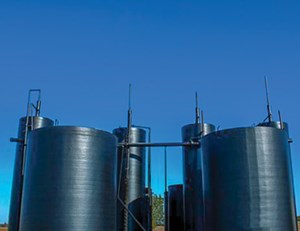Steel tariffs: A campaign promise the oil industry hoped Trump would not keep
It should come as a surprise to no one that, after President Donald Trump (Fig. 1) initially announced on March 1 that his administration would be implementing new, 25% tariffs on imports of steel and aluminum, industry representatives immediately began to voice concerns.

Some in the news media portrayed the President’s announcement as “unexpected,” but no one who has paid attention to how the President has gone about conducting his job should have been surprised in any way. After all, he had promised on many occasions during his 2016 campaign that he would take this exact action, which he believes will create stronger steel and aluminum industries in the U.S.
No president in modern times has been as focused on keeping his campaign promises as has Donald Trump. He has focused on keeping all of them, not just those that would favor or harm certain constituencies.
TRUMP’S DEREGULATORY AGENDA
Indeed, President Trump spent a great deal of time and energy throughout 2017 following through on a broad array of actions that he had promised to take, which are quite positive for the industry:
- The rescission of a group of Obama-era regulations and executive orders that the industry opposed;
- Pulling the U.S. out of the Paris Climate Accords;
- Issuing Executive Orders for restarting the stalled Dakota Access and Keystone XL pipeline projects, along with one rescinding the Obama Clean Power Plan;
- Speeding up energy-related permitting processes at EPA, The Department of Interior and the Department of Commerce (DOC);
- Implementing a new 5-Year Plan that opens up vast new areas of federal waters to oil and gas leasing; and
- Passing a tax bill that is hugely beneficial to the oil and gas industry.
The result of this rapid sea-change in energy policy has been to help stimulate investment in an industry which had spent 2015 and 2016 pulling in its sails to try to weather a perfect storm of low commodity prices and a flood of new regulations coming down from Washington, DC. It isn’t hard to understand that some in the industry thought this honeymoon might go on forever.
But no political relationship between the government and any private industry or business will ever be uniformly positive. The President’s efforts to implement new steel tariffs has placed the industry in the uncomfortable position of speaking out in opposition to an administration that has implemented so many positive policy changes over the previous
13 months.
INDUSTRY’S HEAVY RELIANCE ON STEEL
No industry relies more heavily on the use of steel than the oil and gas industry. Everywhere you look in any oil-and-gas-related operation, you see massive amounts of steel being employed.
Oil storage tanks, including tank batteries in the field? Made with steel, Fig. 2. Dehydrator units and compressor stations and heater-treaters and amine units? Made with steel. Drilling rigs? Made almost entirely with steel. All those pumpjacks moving up and down across the landscapes of the Permian basin, the Eagle Ford shale and the Bakken shale? Made with steel.
The Dakota Access, Keystone XL, Colonial, Transco and every other oil or natural gas pipeline constructed anywhere on the face of the earth? Steel. Those massive deepwater platforms being fabricated at Ingleside, Texas? Fabricated almost entirely from steel. Those gigantic ships exporting crude oil out of Houston and Corpus Christi and LNG from Sabine Pass? Steel, everywhere you look. Those oil refineries arrayed along refinery rows in Houston, New Orleans, Pittsburgh and Corpus Christi? Made almost entirely of steel.
The reality is that you simply cannot separate the oil industry from the steel industry—the two are as intertwined as bread and flour. Steel is the fundamental, indispensable foundation of the oil and gas industry. Given all of that, it is hard to imagine a more effective means of slowing the ongoing oil and gas drilling, production, manufacturing and export boom in the United States than to artificially increase the price for steel via import tariffs.
SHIFTING DETAILS OF THE TARIFFS
When the steel tariffs were first implemented in March, the administration issued temporary exemptions through May 31 for imports from Canada, Mexico, South Korea, Brazil and the European Union. This allowed a little breathing room for the oil industry and other major users of steel, given that those exemptions accounted for well over half of overall U.S. steel imports.
But growing exasperation among the President, Commerce Secretary Wilbur Ross and U.S. trade representatives over unwillingness of other nations to engage in meaningful re-negotiations of NAFTA, and other trade agreements, led Ross to announce the cancellation of the exemptions for Canada, Mexico and the EU, when they expired at the end of May. Thus, going forward, this meant that more than three-quarters of U.S. imports of steel would be subject to the tariffs.
That’s a big deal for companies in every sector of the oil and gas industry. The uptick in the oil price that has taken place over the last half-year has already led to a new round of rising costs for drillers, which always happens. At the same time, the boom in new pipeline construction has already created higher prices for steel for midstream companies, thanks simply to growing demand for the product. Top all of that off with new tariffs on imported steel, and you’re taking a pretty good slice off of everyone’s profit margins.
INDUSTRY WEIGHS IN
The DOC issued an interim final rule in mid-March that would provide an avenue for companies to request an exemption from the tariff. Yet, API and other industry trade associations concluded that the rule is vague and overly-complex. Kyle Isakower, API’s V.P. of Regulatory & Economic Policy, said that “Tariffs will raise the cost of imported steel by 25%, while quotas will stop U.S. businesses from receiving steel for U.S. energy projects around the country—harming the President’s agenda of continuing our energy renaissance, strengthening our infrastructure and creating U.S. jobs. Any disruption of our complex global supply chains of specialty quality steel—in the quantities we need for U.S. energy projects—could negatively impact building energy infrastructure that benefits consumers, the U.S. military and manufacturers.”
The joint letter from the industry trade association group included a set of detailed suggestions for improving the process, including:
- The Final Rule should make clear that exclusions granted apply both retrospectively and prospectively, as not to have costly consequences or create confusion among U.S. businesses.
- The DOC should grant relief for purchases made before tariffs
were announced. - The DOC should define and release metrics that will be used to determine whether U.S. steel manufacturers have the capacity to meet demand, in order to provide greater clarity on how Commerce will make its determination regarding production in the U.S., to supply companies in a sufficient and reasonably available amount.
- The DOC should grant categorical exclusions for products that it determines are not available in the U.S.
- The DOC should defer to companies’ own quality standards, and define and release metrics that will be used to determine whether U.S. steel manufacturers have the capacity to meet demand. This would provide greater clarity on how Commerce will make its determination regarding satisfactory quality steel being produced in the U.S.
As of this writing, the administration had yet to issue its final rule.
CONCLUSION
In the meantime, the Trump administration’s negotiations over NAFTA and other trade agreements with the EU, China and other steel-producing nations move forward. There is no doubt that the President is employing these and other tariffs as leverage to gain concessions in these and other international negotiations. The administration is engaged in negotiations with an array of other countries related to trade and other international matters, and the U.S. is always engaged in a variety of strategic negotiations with China.
While the U.S. economy continues to grow at a rapid pace—the conventional wisdom is that second-quarter GDP growth will approach or exceed 4%—the current impasse over NAFTA is already having negative impacts on the economies of Canada and Mexico. The recent Mexican elections, in which radical leftist Andrés Manuel López Obrador was elected to become the country’s next President on Jan. 1, 2019, further complicate matters.
If, and when, these steel-exporting countries are willing to make concessions desired by the Trump administration, we can expect relief from the related tariffs to take place. Until then, all that companies can do is hope for approval of their exemption filings and work to remain profitable with a higher cost structure. ![]()
- Coiled tubing drilling’s role in the energy transition (March 2024)
- Advancing offshore decarbonization through electrification of FPSOs (March 2024)
- Shale technology: Bayesian variable pressure decline-curve analysis for shale gas wells (March 2024)
- What's new in production (February 2024)
- Subsea technology- Corrosion monitoring: From failure to success (February 2024)
- Using data to create new completion efficiencies (February 2024)



